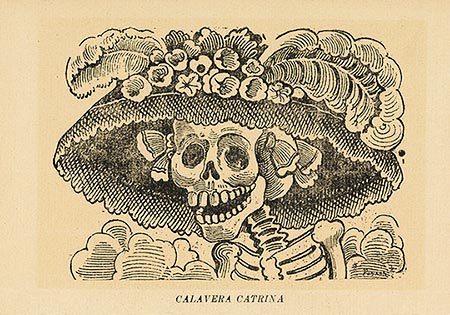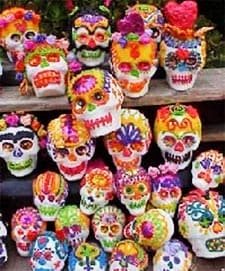Day of the Dead (El Dia de los Muertos), the day departed souls return to earth, is one of the biggest events in Mexico. During this time, families honor their ancestors. Rather than fear death, Mexico celebrates. “The Day of the Dead,” spawned from the Aztec Indian month of Miccailhuitontli.
Prior to the Spanish conquest, festivities over seen by the goddess Mictecacihuatl, the Lady of the Dead, took place in the summer. This month-long celebration commemorated children, the deceased, and Aztec war god Huitzilopochtli. Post conquest era, Spanish priests tried to detract from its focus by pushing the party to the end of October, coinciding with the Christian celebration All Hallows Eve, or Halloween.
The festivities that embody the present holiday blend ancient Aztec traditions with acquired Christian customs. The ceremonies begin at midnight October 31st and last for two days. Usually, November 1st is reserved to remember deceased children, and the 2nd is dedicated to departed adults.
Day of the Dead Rituals
Rituals during the days of the dead, every year after death vary according to regions, but the premise prevails that those who have passed live forever in the hearts of loved ones. Common to all is the intent to welcome the dead and celebrate a sense of familial continuity.
Many rituals start with a candlelight vigil that beckons departed spirits. Elaborate ofrendas (altars) are constructed in the family dwelling as an offering. Trails of marigolds sprinkled outside form trails to guide returning angelitos (little angels) home.
Following the vigil, families flock to the graveyard to socialize among the spirits. The days are spent cleaning and repainting graves on the sacred soil. Many Mexican cemeteries are comprised of small, compact tombstones tiled side by side.

The art attributed to Dia de los Muertos is very well known. Perhaps the best example is Jose Guadalupe Posada. He is famous for his drawings and paintings of his character Christina who is a calavera, a skeleton.
Posada was a Mexican artist, folk illustrator, and political cartoonist and was a fierce supporter of the downtrodden who depicted the horrors and tragedies in bold black and white. The wonderful illustrations he produced have delighted people for many years.
As mentioned before, the building of an altar is to remember the friend or family member who has died. The altar may consist of photographs of the deceased, a special bread called pan de muertos, other foods, and flowers usually marigolds, and special things that were the loved one’s favorites.
One of the forms of art, figurines depicting the loved ones are often seen in the displays. Colorful tissue paper, papel picado, is cut into intricate designs and strung to flutter over around the altar the cemetery, and the graves. This custom comes from the Aztecs, who used paper banners in rituals. Another form of art, the decorated sugar skulls often appear on the altars, in the homes, and in the cemeteries.

The creative imagination of the people allows for so many variations in all of the forms of art associated with the rituals. Colorful tissue paper, papel picado, is cut into intricate designs and strung to flutter over around the altar the cemetery, and the graves. This custom comes from the Aztecs, who used paper banners in rituals.
It is a very special celebration to remember souls who have died and not something that we have in the US. It is important to remember loved ones with what ever type of memorial is appropriate for them and you.

